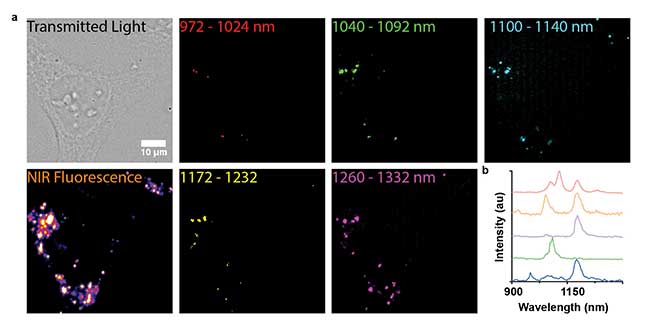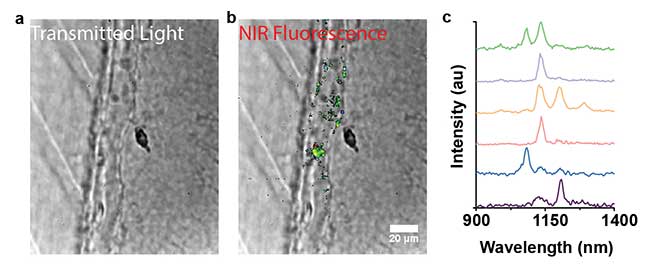Single-walled carbon nanotubes are ideal near-IR markers for small animal multiplex imaging, providing photostable, narrow bandwidth fluorescence in a wide chromatic variety.
LAURA-ISABELLE DION-BERTRAND, PHOTON ETC.
The field of biomedical imaging represents the acquisition of images for diagnosis and treatment evaluation using various imaging techniques, such as magnetic resonance imaging (MRI), ultrasound, x-ray, positron emission tomography (PET) and more. In the past few years, nondestructive techniques based on optical imaging have grown in popularity, as this approach permits visualization of cells and molecules without requiring a biopsy or cell culture.
To obtain in-depth images of complex structures in tissue, the optical acquisition must be carried out in the second biological window (800 to 1700 nm). The reduced absorption, limited tissue scattering and minimal autofluorescence characteristic of this near-infrared (NIR) region greatly facilitate biological imaging. Indeed, IR light can penetrate tissue over a few millimeters while visible light is limited to a few tens of micrometers. Therefore, researchers in academia and in the biotechnology industry seek to develop markers, drugs and diagnostic tools in this window. A multitude of labels have already been developed based on quantum dots, carbon nanotubes, fluorophores, lanthanides and others. When multiple NIR labels are used in the same sample, high spectral and spatial resolutions are required. This is not achievable with standard optical methods; but a hyperspectral wide-field approach can simultaneously spectrally resolve and spatially identify multiple NIR labels in vivo and ex vivo. Even more, this method advances multiplexed imaging of single-walled carbon nanotubes (SWCNTs) in biomedical applications, while enabling single-molecule resolution and deeper optical penetration in tissue.

Figure 1. DNA-SWCNT in lase endosomes and lysosomes of live HeLa cells (DNA-nanotubes are nanotubes where DNA is used as a construction material). (a) Transmitted light, NIR fluorescence and hyperspectral microscopy images of individual DNA-nanotubes in live mammalian cells. Larger wavelength bands were selected for the hyperspectral images to cover the full emission band of each type of single-walled carbon nanotube (SWCNT); colored by nanotube chirality. (b) Measured spectra of five representative SWCNTs in the cells. Images courtesy of Dr. Prakrit Jena, Heller Lab at the Memorial Sloan Kettering Cancer Center and Weill Cornell Medical College.
Biological fluorescent markers
Fluorescence probes that bind to specific molecules are essential tools to assess the characteristics of a tissue or organ. A multitude of fluorescence probes have been synthesized by various research groups. However, not all fluorescence probes are optimized for biomedical imaging. Indeed, multicolor imaging required for biological imaging applications is often restricted by spectrally large emission bands, lack of chromatic variety in the biological transparency window and interference with the optical properties of tissues.
Quantum dots are one of the most popular fluorescent labels due to their remarkable brightness and narrow emission band. These semiconductor nanocrystals exhibit electronic, chemical and optical properties dependent on their confinement and size. When conjugated with biomolecular agents, they can target particular molecules, such as tumors. However, quantum dot probes present a blinking issue, which can be problematic for longer acquisition times, such as when a stable emission source is required. Blinking occurs when a fluorophore emits for a limited time when illuminated continuously, resulting in interrupted emission.
Organic dyes, also popular fluorescent labels, have been used in biological research for the longest time. The dyes’ optical properties are related to the electronic transitions involved during the absorption process1; their quantum yield is very high in the visible range but is quite limited in the NIR region. They are also prone to photobleaching, restricting their use over long periods of time. For these two reasons, organic dyes are not commonly used for NIR imaging.
SWCNTs are cylindrical nanostructures composed of a folded sheet of graphene, measuring 1 to 2 nm in diameter and 50 nm to 1 cm in length2. Depending on their chiralities, SWCNTs emit at different wavelengths, which can be tuned in the visible or NIR region. SWCNTs provide photostable fluorescence with narrow bands (about 20 nm) in a wide variety of chromaticity. Their narrow emission bandwidth enables simultaneous imaging of a large number of spectrally separated markers. SWCNTs have already been imaged in brain blood vessels of live mice3 and used as fluorescence labels for surgical tumor resection4. These NIR markers are ideal because they possess all the specifications required for efficient biological tissue imaging.
![DOC-SWCNT in mouse tissue section (DOC-nanotubes: nanotubes dispersed using deoxycholate [DOC]).](https://www.photonics.com/images/Web/Articles/2016/10/11/Microscopy_Mouse.jpg)
Figure 2. DOC-SWCNT in mouse tissue section (DOC-nanotubes: nanotubes dispersed using deoxycholate [DOC]). (a) Transmitted light image with NIR fluorescence overlay, and hyperspectral microscopy of individual DOC-nanotubes in fixed mouse tissue; colored by nanotube chirality. (b) Extracted spectra from six representative individual nanotubes. Images courtesy of Dr. Prakrit Jena, Heller Lab at the Memorial Sloan Kettering Cancer Center and Weill Cornell Medical College.
Imaging NIR markers
NIR imaging of a wide variety of SWCNTs requires high spectral and spatial resolution. However, it is not possible to distinguish different types of nanotubes with current standard microscopy techniques. Indeed, standard optical microscopic imaging methods either provide integrated fluorescence images or spectrally resolved single points (confocal modality), requiring either the displacement of the sample or of the excitation laser in order to reconstruct a global fluorescence image. An IR hyperspectral global imaging system addresses this challenge by simultaneously spatially resolving and identifying multiple fluorescent nanotubes in vivo.
Bragg’s Law
Hyperspectral global imaging uses global illumination. That means the excitation light is homogeneously distributed over the entire field of view under the microscope objective, and the signal coming from every point in this field of view is simultaneously collected. Before arriving at the detector, the signal is directed through a volume Bragg grating (VBG). Following Bragg’s law, only one wavelength is transmitted through the volume Bragg grating, producing an image of the sample at a given wavelength and with a spectral resolution of approximately 2.5 nm. The transmitted wavelength can be tuned by changing the angle of incidence of the beam on the VBG. A “data cube” is consequently acquired; many images are collected, one wavelength at a time, producing spatial information (X-Y) and spectral information (Z) for every pixel. Distribution maps of given targets can thus be obtained at remarkably high speeds.
Furthermore, in comparison with multispectral imaging of discrete wavelength bands, hyperspectral imaging provides a continuous spectrum over each pixel: A million spectra are acquired when imaging is performed with a megapixel sensor. This hyperspectral system can either be optimized from 400 to 1000 nm or from 900 to 1700 nm (second biological window). The system has already been used to map the diffusion length of charge carriers in solar cells5, to track receptors in neurons6, to map DNA polyfluorophores, to assess the quality of OLEDs and for multiplex imaging of SWCNTs.

Figure 3. DNA-SWCNT in live zebrafish. (a) Transmitted light and (b) hyperspectral microscopy overlay images of a tail fin from a live zebrafish injected with DNA-nanotubes; the different colors exhibited represent different signal signature, hence different carbon nanotube types. (c) Spectra showing individual and multiple nanotubes in representative ROIs (see corresponding colors in (b)). Images courtesy of Dr. Prakrit Jena, Heller Lab at the Memorial Sloan Kettering Cancer Center and Weill Cornell Medical College.
Accelerated drug discovery and cancer diagnosis
Global hyperspectral imaging is a nondestructive technique that provides results containing information on the spectral content and spatial distribution of specific targets. When combined with fluorescent markers optimized in the second biological window, hyperspectral imaging allows deep imaging of living cells and tissues. SWCNTs constitute one of the most efficient fluorescent markers for imaging in the second biological window. Their narrow-band emission, photostability and wide variety of chromaticity make them ideal candidates for multiplexed imaging in cells and tissues. Global hyperspectral imaging has already been successfully used to identify SWCNTs’ photoluminescence signature in live mammalian cells (Figure 1), in mouse tissue ex vivo (Figure 2) and in a zebrafish in vivo (Figure 3). NIR hyperspectral imaging and NIR labels will pave the way toward affordable multiplexed imaging in cells, and eventually be used in small animals. This will greatly accelerate the discovery of new drugs and diagnoses, especially in cancer research, biodistribution studies and drug response monitoring.
Meet the author
Laura-Isabelle Dion-Bertrand is an application scientist with Photon Etc. in Montreal; email: [email protected].
References
1. M. Fang, et al. (2012). Quantum dots for cancer research: Current status, remaining issues and future perspectives. Cancer Biol Med, Vol. 9, pp. 151-163.
2. Z. Liu, et al. (2009). Carbon nanotubes in biology and medicine: in vitro and in vivo detection, imaging and drug delivery. Nano Res, Vol. 2, pp. 85–120.
3. D. Roxbury, et al. (2015). Hyperspectral microscopy of near-infrared fluorescence enables 17-chirality carbon nanotube imaging. Sci Rep 5, pp. 1-6.
4. D. Ghosh, et al. (2014). Noninvasive imaging and surgical guidance of submillimeter tumors using targeted M13-stabilized single-walled carbon nanotubes. Proc Natl Acad Sci USA, Vol. 111, pp. 13948–13953.
5. A. Delamarre, et al. (2013). Evaluation of micrometer scale lateral fluctuations of transport properties in CIGS solar cell. Proc SPIE, Vol. 8620, pp. 862009-1 - 862009-7.
6. S. Labrecque, et al. (2016). Hyperspectral multiplex single-particle tracking of different receptor subtypes labeled with quantum dots in live neurons. J Biomed Opt, Vol. 21, pp. 046008-1 - 046008-11.